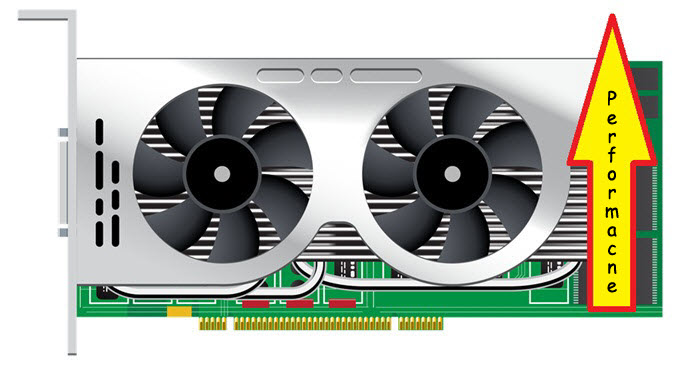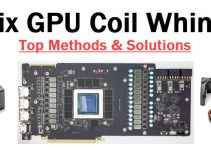Do you want to increase your graphics card performance? If yes then here I am going to tell you how you can do it. Increasing the graphics card performance can give you higher frame rates in the latest high-demanding games. It is not possible for everyone to buy a new graphics card every 6 or 8 months to cope with the new and latest demanding games, but there are some things that you can do to improve the performance of your older or currently owned graphics card.
The increase in the graphics card performance is not the same for all graphics cards even if they are of the same model & make. The average performance increase is in the range of 10% to 20% or more in some cases. The performance increase can give you a definite boost in the games and the graphics-intensive applications or software.

Tips to Increase Graphics Card Performance
Here are the various ways by which you can improve the performance of your current graphics card to a decent margin.
Overclocking
The first and foremost thing that you can do to increase the performance of your graphics card is to overclock it. Overclocking is a risky procedure, especially for novice users but if done correctly then it can improve the performance of your graphics card to up to 25% or more. In overclocking of graphics card you can increase the frequency of both GPU and Memory so as to gain the maximum results and more fps in games. There are some good graphics card overclocking tools available like EVGA Precision X, MSI Afterburner, RivaTuner, etc. which can be used to overclock your graphics card. If you are new to overclocking then you can refer to the guide below on how to overclock a graphics card.
Read: How to Overclock Graphics Card
Update Video Drivers
Updating the video drivers of your graphics card can result in some performance increases in the latest as well as older games. It is also a good practice to update the graphics card drivers to the latest ones. The one piece of advice that I would like to give here is that you should always download the graphics card drivers from the official site of your GPU i.e. Nvidia and AMD. This is because video drivers from third-party sites may contain malware or they may be modified. Also always use the WHQL drivers and not the beta ones for gaming and other software.
Check out: How to Fix Low GPU Usage in Games?
Prevent Overheating
Overheating can also reduce the performance as well as the life of your graphics card. If the temperature of your graphics card reaches above 80 degrees or so then it should be a sign of worry and you must take proper measures to bring it down to a safer level. There are good aftermarket graphics card coolers available which you can buy for your graphics card model to keep its temperature down and within control.
Get Better a CPU
If you have a good graphics card like GTX 1050 Ti but an older dual-core processor then the CPU will bottleneck the graphics card and prevents it from operating at its full performance. So to get the maximum performance out of your graphics in games you must have the right processor which can match the performance of your graphics card.
Check out: Top AMD Ryzen 7 Processors for Gaming PC
Conclusion
Well, in the end, I would like to say that I have covered all the points on increasing the performance of your graphics card. If you have any queries or doubts then you can ask me by leaving a comment below clearly stating your PC configuration.
(*This post may contain affiliate links, which means I may receive a small commission if you choose to purchase through the links I provide (at no extra cost to you). Thank you for supporting the work I put into this site!)
![Why does my PC keep Crashing? [Top Causes & Solutions] Why does my PC keep Crashing? [Top Causes & Solutions]](https://graphicscardhub.com/wp-content/uploads/2021/11/why-does-my-pc-keep-crashing-211x150.jpg)
![PC Power Button Not Working [Solutions and Fixes] PC Power Button Not Working [Solutions and Fixes]](https://graphicscardhub.com/wp-content/uploads/2025/12/pc-power-button-not-working-fix-211x150.jpg)

Nice article about improve graphics performance. Thank you for this information.
nice
Good information, Akshat, thank you for the info!
I’m an AutoCAD guy and my graphics are lagging and slowing me down. I’m wondering if I need a new pc, or just a graphic card upgrader but don’t know what to do.
My pc is an all-in-one HP Pavilion 24-XA0024 with an Intel(R) Core(TM) i5-8400T CPU @ 1.7 GHz.
RAM is 12G, 64 bit and running windows 11.
My display is 8-bit RGB (1920×1080 60Hz
My Display Adapter is an Intel(R) UHD Graphics 630, 128MB
What do you suggest?
Well, I think getting a proper desktop PC with a decent graphics card like GTX 1660 SUPER would be better. You can only upgrade the graphics card in an All-in-one PC or laptop if they have an MXM slot (https://graphicscardhub.com/mxm-graphics-card-gpu-list/). And even if you have an MXM slot finding a compatible MXM graphics card is a very challenging task. Even if you find one it is not guaranteed to work with a laptop or AIO because of BIOS compatibility and power issues. If you have any more queries, feel free to ask.